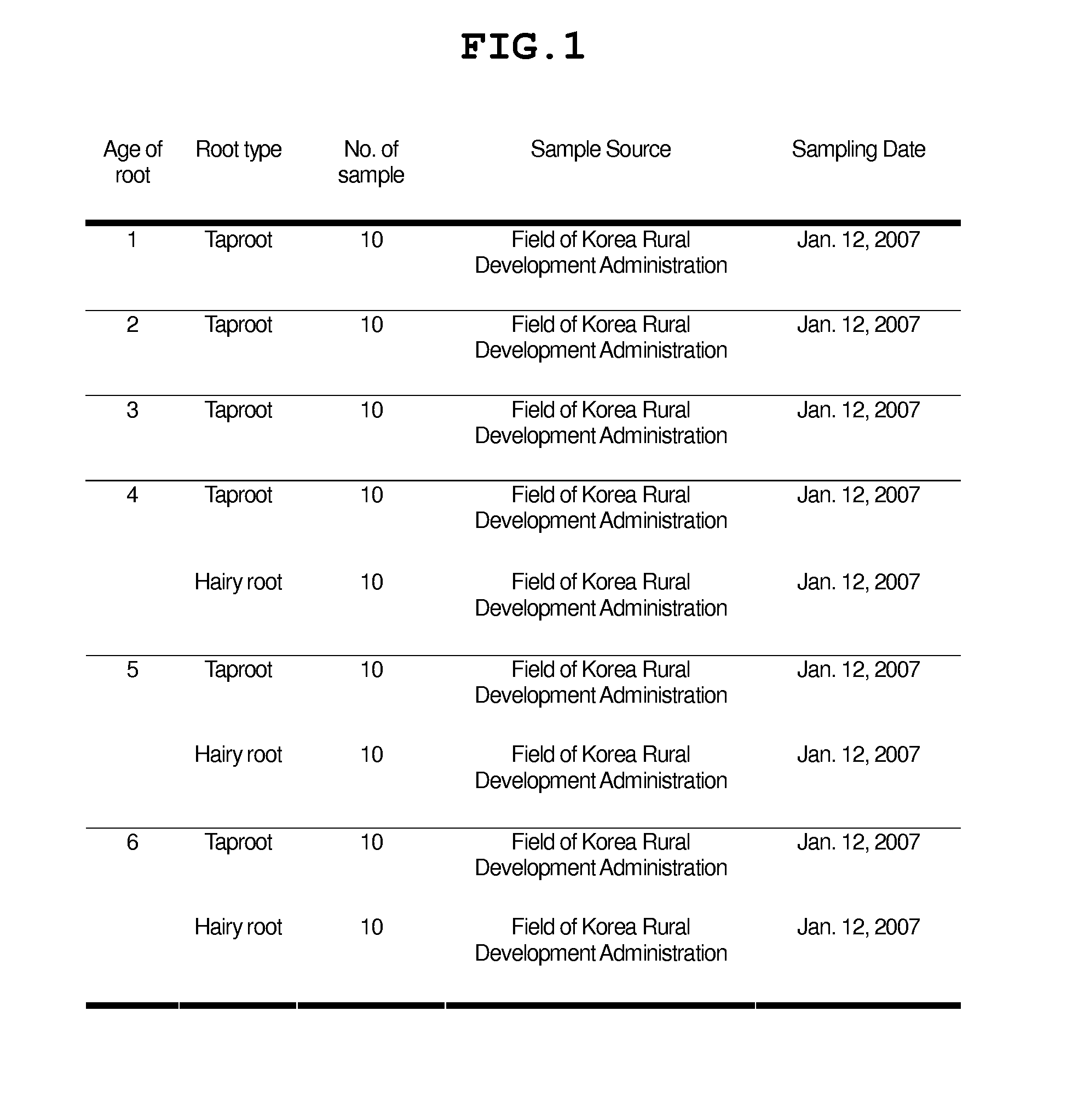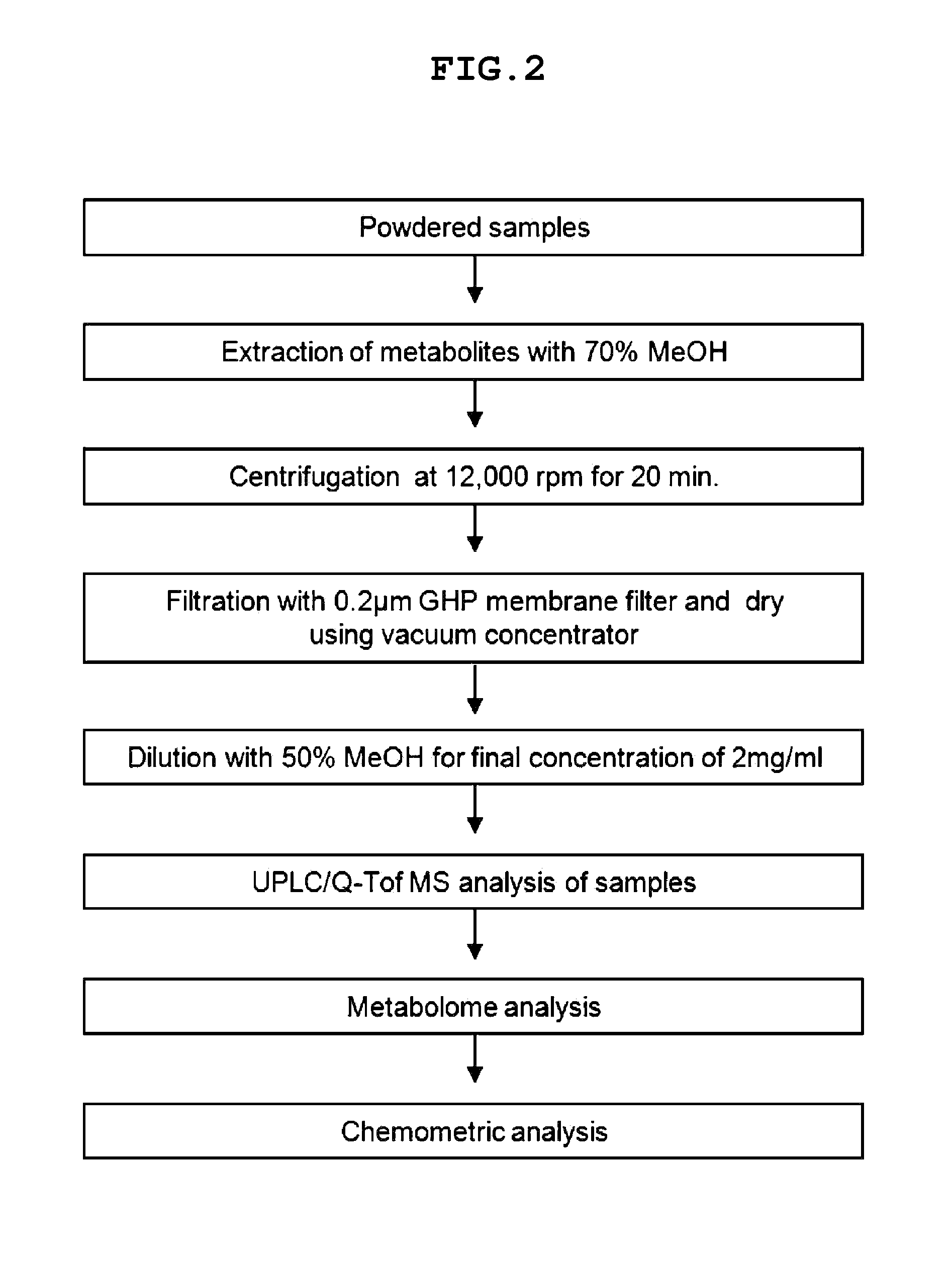Method for determining age of ginseng roots using chromatogramphy-mass spectroscopy
- Summary
- Abstract
- Description
- Claims
- Application Information
AI Technical Summary
Benefits of technology
Problems solved by technology
Method used
Image
Examples
example 1
Preparation of Ginseng Samples (FIG. 1)
[0089]From Panax ginseng C. A. Meyer cultivated at the Rural Development Administration, located in Suwon, Korea, 10 taproots of each of 1- to 6-year-old ginseng, and 10 hairy roots of each of 4- to 6-year-old ginseng were harvested on Jan. 12, 2007.
example 2
Preparation of Specimens for LC / MS Analysis
[0090]LC / MS was performed using UPLC / Q-ToF MS. Specimens, conditions and statistics for LC / MS analysis were as follows.
[0091]1) Preparation of Specimens for LC / MS Analysis (FIG. 2)
[0092]For use in metabolite profiling by LC / MS, metabolites were extracted with 70% aqueous MeOH. To determine the quantity of the metabolites necessary for LC / MS analysis, information about the quantity of extracts, the concentration of analytes, and injection volumes was established by reference to the literature. In this regard, the ginseng samples were cut, freeze-dried just after harvest and powdered, and 50 mg of each powder sample was sonicated for 20 min in 500 μL of 70% aqueous MeOH, followed by centrifugation at 2,000 rpm for 10 min. The supernatant was filtered through a 0.2 μm GHP membrane, and the filtrate was diluted to a final concentration of 2 mg / mL.
[0093]2) LC / MS Conditions (FIGS. 3A and 3B)
[0094](1) UPLC
[0095]A Waters ACQUITY UPLC™ system (Water...
example 3
Preparation of Specimens for GC / MS Analysis
[0102]GC / MS was carried out using a gas chromatography / mass selective detector (GC / MSD). Specimens and conditions for GC / MS analysis were as follows.
[0103]1) Preparation of Specimens for GC / MS Analysis (FIG. 4)
[0104]For use in metabolite profiling by GC / MS, metabolites were extracted with CHCl3: MeOH (1:1). To determine the quantity of the metabolites necessary for GC / MS analysis, information about the quantity of extracts, the concentration of analytes, and injection volumes was established by reference to the literature. Each sample was quantitatively sufficient for conducting experiments therewith in pentaplicate. In this regard, the ginseng samples were cut, freeze-dried just after harvest and powdered, and stored at −80° C. before use. Then, 10 mg of each powder sample was sonicated for 40 min in 1 mL of CHCl3: MeOH (1:1), followed by centrifugation at 10,000 rpm for 5 min. After 200 μL of the supernatant was concentrated, the concentr...
PUM
 Login to View More
Login to View More Abstract
Description
Claims
Application Information
 Login to View More
Login to View More - R&D
- Intellectual Property
- Life Sciences
- Materials
- Tech Scout
- Unparalleled Data Quality
- Higher Quality Content
- 60% Fewer Hallucinations
Browse by: Latest US Patents, China's latest patents, Technical Efficacy Thesaurus, Application Domain, Technology Topic, Popular Technical Reports.
© 2025 PatSnap. All rights reserved.Legal|Privacy policy|Modern Slavery Act Transparency Statement|Sitemap|About US| Contact US: help@patsnap.com



